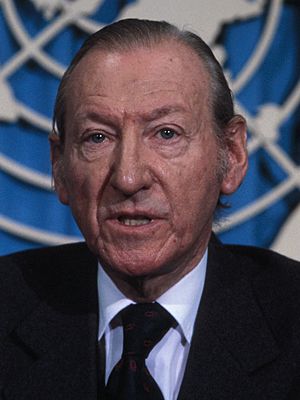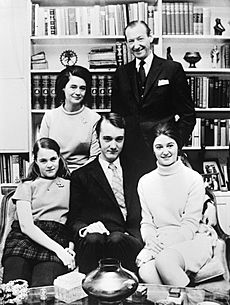Kurt Waldheim facts for kids
Quick facts for kids
Kurt Waldheim
|
|
|---|---|

Waldheim during a press conference at the United Nations Headquarters in 1981
|
|
| Secretary-General of the United Nations | |
| In office 1 January 1972 – 31 December 1981 |
|
| Preceded by | U Thant |
| Succeeded by | Javier Pérez de Cuéllar |
| President of Austria | |
| In office 8 July 1986 – 8 July 1992 |
|
| Chancellor | Franz Vranitzky |
| Preceded by | Rudolf Kirchschläger |
| Succeeded by | Thomas Klestil |
| Minister of Foreign Affairs | |
| In office 19 January 1968 – 21 April 1970 |
|
| Chancellor | Josef Klaus |
| Preceded by | Lujo Tončić-Sorinj |
| Succeeded by | Rudolf Kirchschläger |
| Personal details | |
| Born | 21 December 1918 Sankt Andrä-Wördern, Lower Austria, Republic of German-Austria |
| Died | 14 June 2007 (aged 88) Vienna, Austria |
| Political party | ÖVP |
| Spouse | |
| Children | 3 |
| Alma mater |
|
| Profession |
|
| Signature | |
| Military service | |
| Allegiance |
|
| Branch/service | |
| Rank | Oberleutnant |
| Unit |
|
| Battles/wars | World War II |
| Awards |
|
Kurt Josef Waldheim (born 21 December 1918 – died 14 June 2007) was an important Austrian politician and diplomat. He served as the Secretary-General of the United Nations from 1972 to 1981. Later, he became the President of Austria from 1986 to 1992. During his campaign for president, questions arose about his past service in the German army during World War II.
Contents
Early Life and Education
Kurt Waldheim was born in Sankt Andrä-Wördern, a town near Vienna, Austria, on 21 December 1918. He was the oldest of three children. His father, Walter Watzlawik, was a schoolmaster. He changed the family name to "Waldheim" as the Habsburg monarchy ended.
Kurt grew up in a comfortable middle-class family. He was very tall, standing at 1.92 meters (about 6 feet 3 inches). At school, he was good at languages and played the violin. He also enjoyed sports like swimming and tennis.
Even though his father wanted him to study medicine, Kurt decided he wanted to work in foreign service. In 1936, he joined the Austrian Army for a year. After that, he studied law and diplomacy at the Consular Academy in Vienna.
In 1938, Nazi Germany took over Austria. Kurt and his family were against this. His father was even arrested briefly. Kurt's scholarship was canceled, but he kept studying by tutoring and borrowing money. During this time, he joined some groups connected to the Nazi Party.
In 1944, Kurt Waldheim married Elisabeth Ritschel in Vienna. They had three children: Lieselotte, Gerhard, and Christa.
Military Service in World War II
In early 1941, Waldheim was called to serve in the Wehrmacht, which was the armed forces of Nazi Germany. He was sent to the Eastern Front as a squad leader. He was wounded in December 1941 but returned to duty in 1942.
His service from 1942 to 1945 became a big topic of discussion later in his life. In his autobiography, he said he was discharged from front-line service after being wounded. He claimed he spent the rest of the war finishing his law degree. However, later documents showed that he continued his military service until 1945. During this time, he was promoted to the rank of Oberleutnant (first lieutenant).
Diplomatic Career
After finishing his law studies at the University of Vienna, Waldheim began working for the Austrian diplomatic service in 1945. He worked in Paris and then in Vienna.
In 1956, he became Austria's Ambassador to Canada. He returned to Vienna in 1960. In 1964, he became Austria's Permanent Representative to the United Nations. From 1968 to 1970, he served as the Foreign Minister for the Austrian People's Party. After this, he went back to the U.N. as Permanent Representative. He ran for president of Austria in 1971 but did not win.
United Nations Secretary-General
Kurt Waldheim became the Secretary-General of the United Nations in 1972 and served until 1981. As Secretary-General, he led many important international meetings. These included conferences on trade, the environment, the law of the sea, population, and food. He also attended the World Conference on Women, 1975 in Mexico City.
His efforts to solve problems, especially in the Middle East, were sometimes overshadowed by the diplomacy of the U.S. Secretary of State, Henry Kissinger.
In 1977, Waldheim recorded a special message for the Voyager Golden Records. These records were placed on the Voyager spacecraft and launched into deep space. They contain sounds and images to represent life on Earth to any possible alien life forms.
Waldheim was the first Secretary-General to visit North Korea in 1979. Near the end of his time as Secretary-General, he worked with musician Paul McCartney to organize concerts. These concerts helped raise money for the people of Cambodia after a difficult period.
Presidency of Austria
Waldheim tried again to become President of Austria in 1986, and this time he won. He served as president from 1986 to 1992.
During his presidential campaign in 1985, a controversy began. A journalist revealed that Waldheim's autobiography had left out some details about his life between 1938 and 1945. Waldheim had claimed he was medically discharged from the army in 1942. However, records showed he continued serving until 1945.
The World Jewish Congress stated that Waldheim had not fully shared his military service. They said he had served as an officer in the German army in Yugoslavia and Greece from 1942 to 1944. They also said that a U.N. War Crimes Commission had looked into his past after the war. Waldheim called these claims "pure lies."
Because of the international discussion, the Austrian government asked a group of historians to study Waldheim's life during World War II. Their report found no proof that he was personally involved in any crimes. However, the committee did say that Waldheim must have known about bad things happening around him. They noted that he had very limited power to stop them.
Later Years and Death
After his term as president ended in 1992, Waldheim did not seek re-election. In 1994, Pope John Paul II honored Waldheim and his wife.
Kurt Waldheim passed away on 14 June 2007, at the age of 88, due to heart failure. His funeral was held in Vienna, and he was buried in the Presidential Vault at the Zentralfriedhof (central cemetery).
Austria's Federal President, Heinz Fischer, spoke at the funeral. He called Waldheim "a great Austrian" and praised his efforts to help solve international problems and promote world peace.
At Waldheim's request, no foreign leaders were invited to his funeral, except for the Prince of Liechtenstein. The Secretary-General of the United Nations, Ban Ki-moon, sent a message of sadness. After his death, a letter from Waldheim was published where he admitted making "mistakes" and asked for forgiveness from his critics.
Images for kids
-
Waldheim (second from left) with SS General Artur Phleps (with briefcase) and others in Montenegro, May 1943. This photo caused much discussion during Waldheim's presidential campaign.
See also
 In Spanish: Kurt Waldheim para niños
In Spanish: Kurt Waldheim para niños




